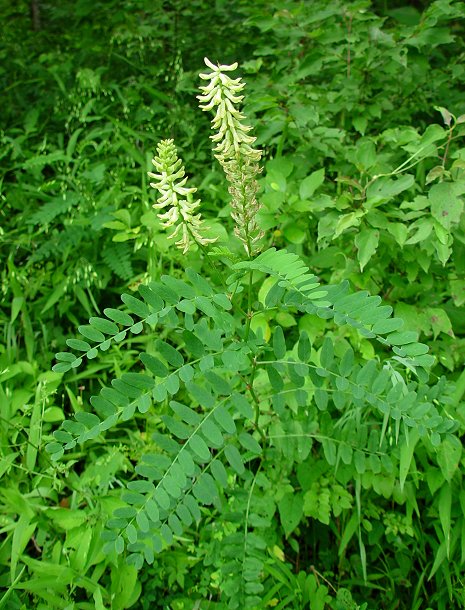Astragalus canadensis L.
Rattleweed

Native
CC = 6
CW = 0
MOC = 65
© DETenaglia
Astragalus canadensis L.Rattleweed | |
 |
Native CC = 6 CW = 0 MOC = 65 |
© DETenaglia |
|
Family - Fabaceae/Faboideae Habit - Perennial forb with woody rhizomes, often colonial. Stems - Multiple from base, loosely ascending to erect, often branched, reddish in strong sun, fistulose, pubescent with appressed, oppositely branched hairs, these centrally attached with branches running parallel to stem.
Leaves - Alternate, odd pinnate, with 15-31 leaflets, the petiole 10-30 mm long, the rachis 14-24 cm long. Stipules 4-18 mm long, pubescent, fused to the petiole toward the base and sheathing the stem, lanceolate, sharply pointed, membranous when young, papery at maturity. Leaflets opposite, 10-50 mm long, 5-15 mm wide, reduced in size toward tip of leaf, lanceolate to oblong, elliptic, or ovate, rounded or bluntly pointed at the tip, mucronate, the upper surface glabrous to sparsely hairy, the undersurface sparsely to densely branched-hairy. Petiolules to 1.5 mm.
Inflorescence - Axillary, elongate, spikelike racemes, 12-30 cm long, the stalk 4-14 cm long, with 30-70 flowers, the bracts 3-5 mm long, hairy. Inflorescence rachis ridged, pubescent. Pedicels 1.1 mm long, hairy, each subtended by a linear-attenuate bract to 6 mm long.
Flowers - Slightly drooping. Cleistogamous flowers absent. Calyces with the tube 4-7 mm long, less than half the length of the corollas, broadly cylindric, somewhat pouched, sparsely hairy, whitish-green, 5-lobed, the lobes 1-4 mm long, linear. Corollas papilionaceous, to 2 cm, greenish yellow to cream-colored or white, sometimes tinged with purple or spotted with red, the banner 11-16 mm long, 5-6 mm wide, usually bent or curved upward, the wings 10-14 mm long, the keel 9-13 mm long. Stamens diadelphous, the fused portion 7-8 mm long, the free portion 2-4 mm long. Anthers yellow. Styles 7-8 mm long, white, glabrous, upcurved.
Fruits - Inflated legumes, 12-18 mm long, 5-7 mm wide, ovoid to oblong-ovoid, not curved, beaked with persistent style, ascending to spreading, 2-locular, usually glabrous, yellowish brown, tardily dehiscent by 2 apical valves. Seeds 1.5-2.0 mm long, the surface olive or reddish brown, smooth or nearly so. Seeds about 10.
Flowering - May - August. Habitat - Thickets, wet lowlands, pastures, prairies, upland woods, waste ground. Origin - Native to the U.S. Other info. - This species can be found in scattered locations throughout most of Missouri, and across all but the far western states of the continental U.S. The plant is easy to identify while in flower but vegetatively it can be mistaken for many other plants. It is Missouri's most common member of the Astragalus genus, a genus which is one of the largest in the plant kingdom. In western regions of the U.S., the number of Astragalus species becomes much larger, and there they can be difficult to tell apart. The species has been subdivided into numerous infraspecific taxa. Missouri plants are assignable to var. canadensis. Photographs taken at the Kansas City Zoo, 7-10-00, and in the Ozark Scenic Riverways, Shannon County, MO., 7-6-03 (DETenaglia); also at Shaw Nature Reserve, Franklin County, MO, 7-11-2011, Marais Temps Clair Conservation Area, St. Charles County, MO, 7-19-2010 and 7-22-2013, and Little Lost Creek Conservation Area, Warren County, MO, 7-8-2020 (SRTurner). |